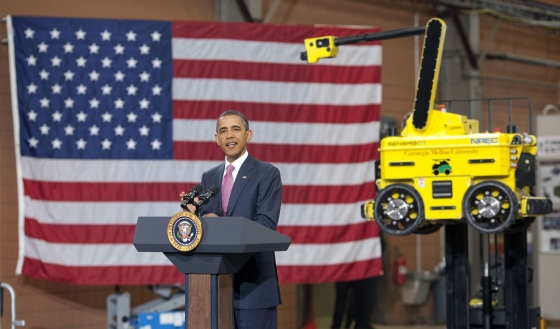Obama on Technological Innovation and Renaissance of US Manfacturing
“We don’t just keep up with changing times, we set the pace”

[Update 2 : 6/26/11 – Just read the NY Times story. So, in addition to a questionable corporate co-chair, Obama provided no policy agenda and no real funding. How is it possible to stimulate what Obama described as a “renaissance” without policy or money? As the Times story alludes to, Obama is beginning to deliver the same message in swing states. So, my take is that this initiative is more rhetoric and political message, than policy. It is an “umbrella”, not for policy coordination, but as a political shield against criticism on the jobs front.
Again, this is a huge missed opportunity, because Obama could have really used this initiative as a way to pivot from his economic austerity (budget deficit dominated) agenda driven by Wall Street finance and Republican Teabaggers, to a major New Deal like Keynesian jobs and domestic investment program, and political response to: 1) Depression Era unemployment; 2) huge infrastructure deficits; and 3) tremendous renewable energy opportunities.
Update 1: 6/25/11 – a supporter delicately let me know that the Obama’s “Advanced Manufacturing Partnership” initiative is co-chaired by Dow Chemical Corp. That’s not a very good sign. Dow is not the kind of innovation or manufacturing we need. The chemical industry expects that the Dow appointment will result in favorable regulatory policies for the chemical industry. Dow co-chair also champions free trade – which has been used to destroy US manufacturing, offshore jobs, and implement a corporate race to the bottom strategy of cost reduction by sacrificing environmental and labor protections for windfall profits. This is the crap I hate most about Obama – the rhetoric soars and the fine print sucks. Gotta fine print and fact check everything with this guy. That’s a real problem when he can smoke a hard core skeptic (borderline cynic) like myself. Or maybe I’m just getting lazy and just was looking for some good news on a Friday afternoon. But at least the Universities that are participating are all elite.]
President Obama spoke today at Carnegie Mellon University (CMU) about technological innnovation and reinvigoration of the US manufacturing sector (watch it).
Here is the text of the speech (with more pictures from White House blog)
Not only did I enjoy the speech, but I’m proud to say that both my kids attend CMU, a world class University with roots in Pittsburgh’s steel mills (Andrew Carnegie’s motto: “My heart is in the work“).
My son just graduated with honors and will move on to a PhD program in computer science at Johns Hopkins. My daughter just finished her junior year at CMU’s Tepper business school. (Ironically, I declined a full scholarship from Carnegie Tech in 1975).
As someone who views these issues from environmental and economic justice perspectives, I was pleased by Obama’s linkage of innovation to renewable energy and green jobs and focus on domestic opportunities.
As a member of the Luddite school (the Luddites got a bum rap), a skeptic of technology, and a critic of the positivists and technological utopians, I was comforted that Obama, at the outset, explicitly recognized that there were social and economic dislocations associated with the “creative destruction” of technological innovation.
However, I wish he had gone further and talked about the devastation caused by the conscious deindustrialization of America and structural flaws in our finance driven economy.
And Obama may have gone over the line in reinforcing the great American myth. He praised the “adventurous pioneering spirit” of the sole technological innovator (you know: the unfunded and obscure individual – from Henry Ford and Thomas Edison to Steve Gates – working in the garage, that produce great breakthroughs).
In contrast to the myth of the 19th century rugged individualist, innovations in science and technology today are driven by large institutions, huge public investments, and collaborative efforts.
Obama himself recognized this reality by noting the critical role of the University in conducting research that was does not have an immediate commercial application and thus does not attract private capital investment.
These economic investment realities (what I learned were “public goods” and “market failures”, back in the day of “industrial policy”) are what drive the need for public investment – and university development and incubation.
These are major policy premises of Obama’s “Assuring Leadership in Advanced American Manufacturing“.
I hope these critical issues get more attention by both the media and the political process.
Carnegie Mellon University
